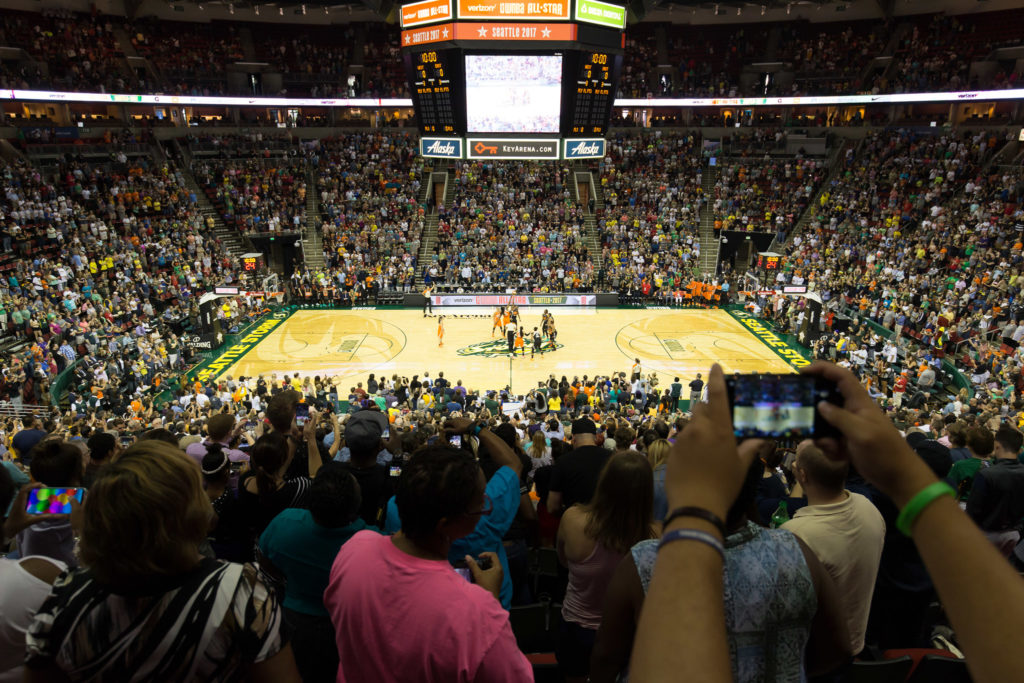When Seattle’s Bank of America Arena at Hec Edmundson Pavilion reopened on November 24, 2000, after a major, 19-month renovation, UConn junior Sue Bird was on the floor against the University of Washington in the very first basketball game played there.
For Bird, that history might be on the verge of repeating itself.
After her UConn career ended in 2002, Bird was the first overall pick of the Seattle Storm in the WNBA Draft, and since then, the U.S. Olympic-champion point guard has called Seattle’s KeyArena her home court.
But KeyArena is preparing to go dark for a two-year, $600 renovation project, leaving Bird and the Storm looking for a new home in the 2019 and ’20 seasons. But if Bird, who will be just shy of 41 in the summer of 2021, is still playing and still with the Storm, she will once again be on the floor when a Seattle-area arena reopens its doors.
The Storm have been the sole major sports tenant at KeyArena since the departure of the SuperSonics to Oklahoma City in 2008. The arena, which was the original home of the SuperSonics when the franchise joined the NBA in 1967, will be undergoing its first major renovation since a makeover in 1994-95 to get up to modern NBA specifications.
This latest renovation is designed to net Seattle both an NHL and an NBA franchise, with the NHL team the more realistic goal when the arena re-opens in 2020. In the meantime, it leaves the Storm, which joined the WNBA in 2000 and has played all its home games at KeyArena since then, searching for a temporary home after playing the 2018 season this summer.
According to a draft Environmental Impact Statement released in April by the City of Seattle, there are four possible landing points for the Storm over the next two seasons: the 10,000-seat Alaska Airlines Arena, where the University of Washington plays (and where Bird and UConn took part in the renovated arena’s opening game in 2000); the 23,000-seat Tacoma Dome (depending upon the seating arrangement), where the SuperSonics played the 1994-95 season during KeyArena’s previous renovation; Angel of the Winds Arena in Everett (capacity 10,000), or the ShoWare Center in Kent (capacity 6,500).
In its first 18 seasons at KeyArena since joining the WNBA in 2000, the Storm have made the playoffs 13 times and won a pair of championships, in 2004 and ’10. All the Storm’s success traces back to a pair of No. 1 overall selections in the WNBA draft after dismal showings in the team’s first two seasons.
In 2001, the Storm selected 6-foot-5 Lauren Jackson from Australia with the top overall pick. An established superstar in Australia before ever coming to Seattle, Jackson would go on to win three WNBA MVP awards (2003, ’07, ’10), seven league All-Star selections and three scoring titles (2003, ’04, ’07) in her 12 seasons with the Storm.
In 2002, the Storm followed up the Jackson pick by selecting Bird, a point guard and two-time national champion at UConn, in the 2002 Draft. Bird, a 10-time All-Star, is the league’s all-time assist leader.
The duo of Bird and Jackson catapulted the Storm to their first championship in 2004, defeating the Connecticut Sun in the decisive third game of the WNBA Finals. In 2010, the Storm put KeyArena in the record books, becoming the first WNBA team to go 17-0 at home en route to the franchise’s second league title, defeating Atlanta in the championship round.
Image courtesy Seattle Storm.
This article originally appeared in the weekly Arena Digest newsletter. Are you a subscriber? Click here to sign up for the free weekly newsletter


